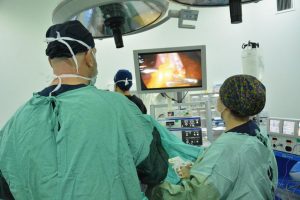Laparoscopic Surgical Procedures

With each passing day, the development in the field of technology has also brought innovations to the applications in the field of surgery (e.i: abdominal, gynaecology). A light camera which is the actual tool that is connected to the pelvic organs with the help of a thin optical tube. Unlike open surgery, in a laparoscopic surgery, a camera is used that is inserted into a small incision, not large incisions, to look at the patient’s abdomen.
- Infertility
- Chocolate cyst (Endometriosis)
- Unblocked of tubes or removing the damaged tubes
- Myoma
- Ectopic pregnancy
- Endometriosis
- Removal of ovarian cysts
- Removal of the uterus
- In sterilization processes
- Opening of intra-abdominal bond
- Laparoscopic surgery method is applied for diagnosis and treatment of conditions such as uterine sagging, urinary incontinence, urinary bag sagging, vagina sagging, chronic pain, which are defined as pelvic problems.
Laparoscopic surgery is a treatment that gives the patient many advantages. The minimum risk of infection, short hospitalization time and much less pain are the advantages of laparoscopic surgery. Laparoscopic surgery is performed under anesthesia. In some cases, the patient can go home on the day of surgery and in some cases may have to be in bed between 1 and 2 days.
Previously, a gallbladder surgery was performed by cutting at least 7 cm of space in the abdominal wall. Laparoscopic surgery is made by opening two 0.5 cm, two 1cm four particles. This surgery be further developed, and interventions can be performed on four needle-thick applicators (needles). In addition, endoscopic devices used to examine the digestive system through the mouth or purpose have been highly developed.
What are the Pros of Laparascopic Surgery?
Less pain after operation. The patient gets up quickly and naturally his hospitalization time is shortened. In addition, aesthetically, much better results are formed.
What Surgeries Can Be Performed with Laparoscopic Surgery?
Lung, liver,stomach hernia, intestine, gallbladder, kidney, adrenal gland, spleen, appendicitis, abdominal wall and hernia.
Laparoscopic Colon and Rectum Surgeries
After many years of laparoscopic surgery (thick bowel and rectum diseases) it has now started to be applied in cancers today. While there is no difference between open surgery all advantages of laparoscopic surgery are also maintained.
Laparoscopic Hiatal Hernia (Gastric Hernia) and Reflux Esophagus (GERD) Surgery
It can be with a hernia of the stomach, as well as reflux disease alone. Stomach acid damages the esophagus due to the disorder at the lower end of the esophagus. With 5 trocar, it is prevented by laparoscopic technique, which is applied to both stomach hernia and reflux by entering through the abdominal wall.
Laparoscopic Splenectomy (Spleen Surgery)
In surgical diseases of the spleen, the spleen can be taken laparoscopically with 3 or 4 trocar inflows. The spleen, which is separated by special laparoscopic devices, is taken into a bag in the abdomen and is absorbed from a 1 cm trocar hole opened on the abdominal wall after it is broken down in this bag.
Laparoscopic Appendectomy (Acute Appendicitis)
The abdominal wall is opened in the lower right section of the 1 cm and 2 0.5 cm from three entrances, appendix is cut into the bag and removed from a 1 cm hole outside the abdomen.
Advantages of Laparoscopic Surgery
Laparoscopic surgery in experienced hands gives good results from surgery performed by opening the abdomen. The main advantages of laparoscopic surgery are:
- The fact that surgeries can be performed without long incisions results in much less surgical scars.
- Laparoscopic surgeries cause fewer side effects, especially bleeding and infection, comparing with many types of surgeries.
- Less tissue damage in the surgical area provides easier and faster recovery. Abdominal adhesions that occur after open surgeries and cause distress for the rest of their lives.
- One of the most obvious advantages of laparoscopic method is that the patient has much less pain after surgery.
- Laparoscopic surgery also gives a shorter hospital stay. It is also easier and faster for the patient to have normal physical activity and return to work.
What need to know after surgery?
After surgery, patients may feel a slight pain in the incision area. Pain may occur on the shoulder and back. The patient can stand up 3 to 5 hours after surgery. After laparoscopic surgery, it is recommended that patients rest for a certain period.
If you want you can reach us via Whatsapp. Our number : +905447663030
